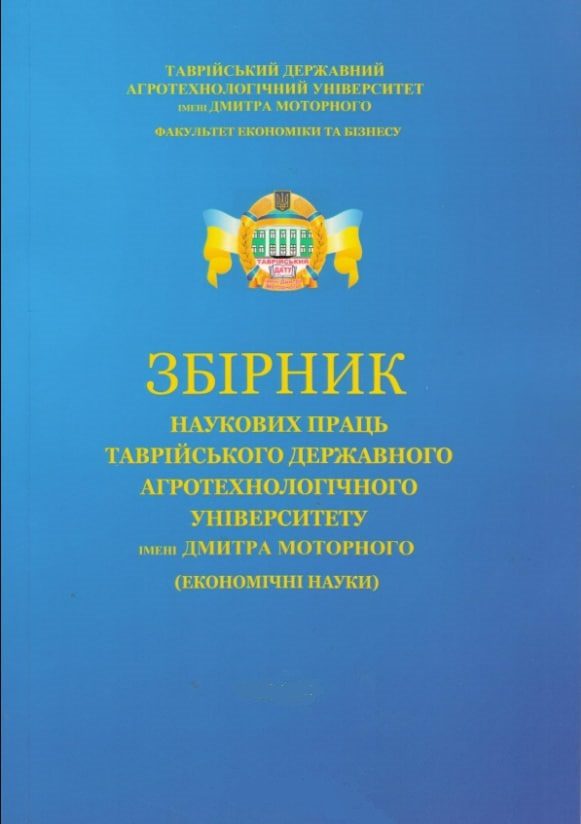ОЦІНКА ЕФЕКТИВНОСТІ РЕАЛІЗАЦІЇ АЛЬТЕРНАТИВНИХ БІЗНЕС-ПРОЕКТІВ ЗА ЗМІНИ СТАВКИ ДИСКОНТУВАННЯ ГРОШОВИХ ПОТОКІВ ТА СТРОКІВ ЇХ ВИКОРИСТАННЯ
Ключові слова:
інвестиційний проект, ставка дисконтування, чиста теперішня вартість, індекс доходності, період окупності, внутрішня ставка доходності
Анотація
Анотація. У статті розглянуто підходи до оцінки ефективності реалізації альтернативних проектів на основі динамічних методів, що враховують фактор часу. Розкрито сутність кожного показника, окреслено характеристики та особливості розрахунку. Зазначено, що вибір ставки дисконтування є важливим етапом прийняття управлінських рішень у процесі інвестування. Проаналізовано доцільність застосування загальноприйнятих назв показників, зокрема, чистої теперішньої вартості, внутрішньої ставки доходності. Запропоновано ітераційний метод розрахунку періоду окупності для альтернативних бізнес-проектів, що характери-зуються інтервальним інвестуванням в галузі птахівництва.
Посилання
1. Мамотенко Д.Ю. Оцінка ефективності інвестиційних проектів / Д. Ю. Мамотенко // Вісник Національного університету «Львівська політехніка». Серія «Проблеми економіки та управління». – 2008. – № 628. – С. 209–216.
2. Орлик О.В. Методи оцінювання ефективності інвестиційних проектів /О.В. Орлик // Вісник соціально-економічних досліджень: зб. наук. пр. – ОДЕУ: Одеса. – 2005. – Вип. 21. – С. 179–185.
3. Пересада А.А. Інвестиційний аналіз: Навчально-методичний посібник для самостійного вивчення дисципліни. / А.А. Пересада, С.В. Онікієнко, Ю.М. Коваленко. Київ: КНЕУ. – 2003. – 134 с.
4. Stehnei M. Modeling of strategic control system in the context of sustainable development of enterprise / M. Stehnei, I. Irtysheva, K. Khaustova, Y. Boiko. Problems and Perspectives in Management. LLC «Consulting Publishing Company «Business Perspectives». – 2017. – № 3(15). – Р. 212–223.
5. Basil R. Acquisition versus Greenfield investment: the location of foreign manu-facturers in Italy / R. Basil // Regional Science and Urban Economics. – 2004. - № 34. - РР. 3-25.
6. Bath V. Foreign Investment the National Interest and National Security – Foreign Direct Investment in Australia and China / V. Bath// Sydney Law Review. – 2012. – РР. 5-34. – [Електронний ресурс]. – Режим доступу: http://papers.ssrn.com/so13/.
7. Аликаева М., Шовгенов А. Инвестиционная безопасность в экономическом обосновании инвестиционной политики / М. Аликаева, А. Шовгенов. М.: СПбГУЭФ. – 2002. – 345 с.
8. Boush G., Grasmik K., Pyatkov M. Potential risks of attracting foreign direct investment in the formation of regional clusters / G. Boush, K. Grasmik, M. Pyatkov // Economic of the region. – 2012. - №1. – РР. 118-127.
2. Орлик О.В. Методи оцінювання ефективності інвестиційних проектів /О.В. Орлик // Вісник соціально-економічних досліджень: зб. наук. пр. – ОДЕУ: Одеса. – 2005. – Вип. 21. – С. 179–185.
3. Пересада А.А. Інвестиційний аналіз: Навчально-методичний посібник для самостійного вивчення дисципліни. / А.А. Пересада, С.В. Онікієнко, Ю.М. Коваленко. Київ: КНЕУ. – 2003. – 134 с.
4. Stehnei M. Modeling of strategic control system in the context of sustainable development of enterprise / M. Stehnei, I. Irtysheva, K. Khaustova, Y. Boiko. Problems and Perspectives in Management. LLC «Consulting Publishing Company «Business Perspectives». – 2017. – № 3(15). – Р. 212–223.
5. Basil R. Acquisition versus Greenfield investment: the location of foreign manu-facturers in Italy / R. Basil // Regional Science and Urban Economics. – 2004. - № 34. - РР. 3-25.
6. Bath V. Foreign Investment the National Interest and National Security – Foreign Direct Investment in Australia and China / V. Bath// Sydney Law Review. – 2012. – РР. 5-34. – [Електронний ресурс]. – Режим доступу: http://papers.ssrn.com/so13/.
7. Аликаева М., Шовгенов А. Инвестиционная безопасность в экономическом обосновании инвестиционной политики / М. Аликаева, А. Шовгенов. М.: СПбГУЭФ. – 2002. – 345 с.
8. Boush G., Grasmik K., Pyatkov M. Potential risks of attracting foreign direct investment in the formation of regional clusters / G. Boush, K. Grasmik, M. Pyatkov // Economic of the region. – 2012. - №1. – РР. 118-127.
Опубліковано
2019-02-10

